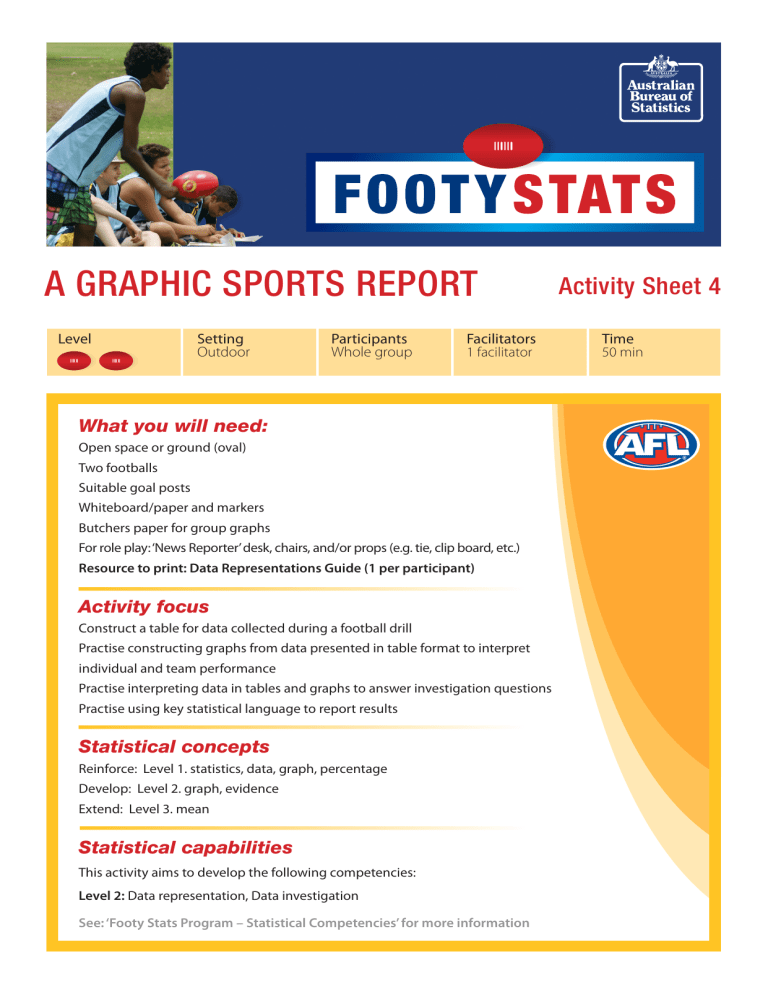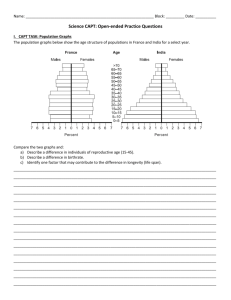A GRAPHIC SPORTS REPORT Activity Sheet 4 What you will need: Level

A GRAPHIC SPORTS REPORT
Activity Sheet 4
Level Setting Participants Facilitators Time
Outdoor 1 facilitator 50 min Whole group
What you will need:
Open space or ground (oval)
Two footballs
Suitable goal posts
Whiteboard/paper and markers
Butchers paper for group graphs
For role play: ‘News Reporter’ desk, chairs, and/or props (e.g. tie, clip board, etc.)
Resource to print: Data Representations Guide (1 per participant)
Activity focus
Construct a table for data collected during a football drill
Practise constructing graphs from data presented in table format to interpret individual and team performance
Practise interpreting data in tables and graphs to answer investigation questions
Practise using key statistical language to report results
Statistical concepts
Reinforce: Level 1. statistics, data, graph, percentage
Develop: Level 2. graph, evidence
Extend: Level 3. mean
Statistical capabilities
This activity aims to develop the following competencies:
Level 2: Data representation, Data investigation
See: ‘Footy Stats Program – Statistical Competencies’ for more information
Activity Sheet 4
Learning Activities and Experience Time
Introduction
Conclusion
Create two equal teams for a short goal kicking practice activity:
• Team 1 participants take turns to practise goal kicking.
Team 2 assist the facilitator to record the number of goals kicked by each participant on the whiteboard/paper
• Team 2 kicks, while Team 1 assists facilitator to record the results
Body In teams, record individual scores and create a table of results on the
whiteboard/paper
Collectively, create a list of the statistical information within the data, such as the number of goals each participant kicked from the team’s table of
results
Each facilitator works with their own group to analyse the data
Participants use the data in the table to create a graph answering questions about the data, such as:
• Which team scored the most goals?
• Which participant scored the most goals?
• If mixed game: Did the boys or the girls perform better on the day?
Set-up a table as a ‘News Desk’ for role play
The two teams present their footy statistics (based on the above questions that they used to create the graph) as sports reporters:
• Participants use the graph as evidence to describe data
• Participants discuss the type of graph they chose to most effectively
present the data
• Facilitator to encourage participants to take part in the question and
answer discussion about their graphs.
15 min
20 min
15 min
Activity Sheet 4
Why this is important
The ABS Footy Stats program provides a fun and interactive introduction to the world of statistics. The program enables children to participate in a range of footy activities and learn how to collect, analyse, interpret and communicate basic statistical concepts.
In this activity, participants:
• Draw on previously developed graphing skills to produce a graph to solve investigation questions; justifying the choice of graph type
• Develop skills to record data in tables, and to construct graphs to investigate drill performance
• Demonstrate the ability to accurately read and describe the data in tables and graphs using key statistical concepts
What you do
Evaluate the statistical learning of the participants:
• Are participants able to recall and apply their previous learning to choose a type of graph to best present data in answer to an investigation question?
• Are participants able to construct tables and graphs from recorded data to answer investigation questions?
• Are participants able to communicate data as statistical evidence to answer their investigation questions using their group graphs?
Explore statistical concepts further with this activity
Percentage:
• Calculate and compare the percentage of goals scored by each team
Mean:
• Each team calculates the mean for the number of goals their team members scored by dividing the total number of goals scored by the number of team members in the team. Compare the two teams’ mean scores.



